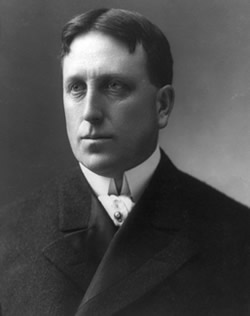 |
| William Randolph Hearst |
There were other public moments when charges of Hearst-generated conspiracies were alleged. Among the most interesting are those associated with the McKinley assassination, the death of Hollywood producer Thomas Ince, and the campaign to expunge Welles’s classic film Citizen Kane.
In the history of modern media, perhaps no individual was more skillful in marshaling the tools of communication to promote his own agenda than William Randolph Hearst. His early twentieth-century media empire—which he built through the inherited wealth of his father’s mining enterprises—was influential in a way not easily appreciated today.
At the peak of his power he owned twenty-eight newspapers, with most of them in the largest U.S. cities, as well as eighteen widely circulated magazines, influential film studios, several radio stations, and for a time a political constituency of national consequence.
  |
Hearst was more than a media figure. He was outsized in his influence, and his ego. His grasp of the media matrix in its infancy was as thorough as his commitment to push his agenda on the U.S. public, and his use of the tools of technology to advance his own causes—from the global (Spanish-American War) to the ephemeral (the film career of chorusgirl-turned-actress Marion Davies)—earned him the requisite fear, awe, and contempt of his media brethren. Financially wounded by the Great Depression and undermined by the backlash against his pro-German sympathies in the 1930s, his massive empire and influence declined throughout the last decade of his life.
Although he died 14 August 1951, the Hearst Corporation remains a formidable publishing conglomerate, employing nearly 20,000 people and producing dozens of magazines and newspapers, as well as maintaining an active presence in business publishing, cable television, radio, even real estate.
The McKinley Assassination
Establishing a pattern that would become familiar to readers of his newspapers for half a century, Hearst mercilessly attacked the sitting president during his reelection campaign in 1900. Hearst’s papers assailed President William McKinley in their news stories and front-page editorials, and savagely delineated him and his Republican cronies in cartoons. Hearst attacked McKinley for his support of wealthy industrialists, his pro-trust business policies, and his anti-working-class hubris.
When a crazed assassin named Leon Czolgosz murdered McKinley at the Buffalo World’s Fair in September 1901, some Republican politicians and many Republican newspapers accused Hearst of inflaming the murderous hatred of Czolgosz through editorials such as the one published in Hearst’s papers the previous April: “If bad institutions and bad men can be got rid of only by killing, then killing must be done.”
Competing newspapers and a handful of powerful politicians were quick to denounce this Hearst-generated pattern of stirring up the masses through his papers’ consistent, coordinated attacks on McKinley.
According to biographer David Nasaw, no less a figure than Vice-President Theodore Roosevelt fingered Hearst as bearing some responsibility for the assassin’s act: “Every scoundrel like Hearst and his satellites who for whatever purposes appeals to and inflames evil human passion has made himself accessory before the fact to every crime of this nature.”
Death on the Water
Another death—and a more enduring suspicion about Hearst’s direct involvement—enmeshed the publisher in November 1924. Movie producer Thomas Ince, who was celebrating his forty-third birthday at a star-studded private party aboard Hearst’s yacht, the Oneida, died shortly after being taken off the boat early the following morning. Although Hearst claimed that Ince had suffered a heart attack on board, there was rampant speculation in the gossip columns and throughout Hollywood that Hearst had murdered Ince.
Murmured motives included everything from an untenable clash of egos to, more salaciously, a theory that Hearst shot Ince while he was firing at Charlie Chaplin, who was allegedly having an affair with Hearst’s mistress Marion Davies. The “Hearst-shot-Ince-while-gunning-for-Chaplin” theory was the premise of a 2001 film, The Cat’s Meow, directed by Peter Bogdonovich and adapted from Steven Peros’s play about the incident.
No evidence has ever been produced linking Hearst to the crime, although his yacht full of media-connected guests (a regular group of revelers who usually partied at Davies’s Los Angeles mansion, according to Chaplin) remained uncharacteristically silent about the incident. The conspiracy theorists claim Hearst swore them all to silence and that none of the witnesses would have risked incurring the wrath of the media giant by revealing the truth.
Razing Kane
Hearst’s attempt to squelch distribution of Orson Welles’s 1941 masterpiece, Citizen Kane, led to what several biographers have called a “clash of titans.” Hearst—informed by columnist Hedda Hopper after she screened the movie that the portrayal of Kane/Hearst was a “vicious and irresponsible attack”—pulled out all the stops to keep the movie from being shown (Carringer).
In one of the earliest examples of the power of vertical media integration, Hearst allegedly threatened Kane’s producers, RKO, with an advertising blackout of all future RKO movies in Hearst magazines, newspapers, and newsreels.
Hearst supposedly promised unflattering, magazine-length profiles of RKO executives in his publications and reportedly even threatened to initiate FBI investigation of members of the RKO board of directors and of executives associated with the film. Hearst’s newspapers labeled Welles a Communist sympathizer and attacked his association with a group of radio writers and directors called “The Free Company,” whom Hearst labeled as anti-American leftists.
The film did eventually open, though in limited release around the country. Despite its widespread celebration by reviewers (Time magazine called it “Hollywood’s greatest creation”), the film—battered by Hearst’s preemptive publicity strikes—was a commercial failure. Only after RKO sold its film library to television in 1956 did the movie find its audience. In 1962, the film magazine Sight and Sound voted it the greatest film ever made.
Hearst didn’t kill Citizen Kane, but he wounded it, and it wouldn’t be until well after “the Chief” (as his employees called him) was dead that his quasibiographical counterpart Charles Foster Kane became, for a new generation of media consumers, the enduring icon of a once-mighty publishing empire.